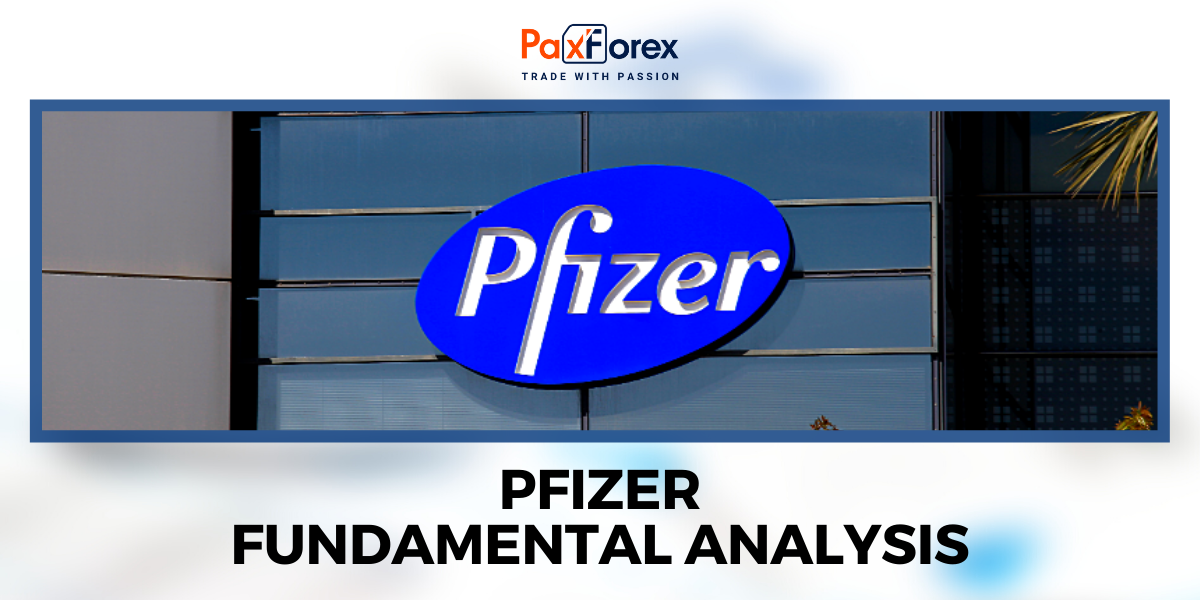
Source: PaxForex Premium Analytics Portal, Fundamental Insight
This year is sure to be a strong one for Pfizer. The maker of the COVID-19 vaccine will see a huge increase in sales this year, which management predicts will be about $100 billion. More than half of that amount will come from sales of the COVID-19 vaccine (Comirnaty) and tablets (Paxlovid), which together will total about $54 billion.
Despite a projected 23% increase in revenues, the company's stock performance has been disappointing. Pfizer stock is down 9% over the past year, which is only slightly better than the S&P 500's 13% decline over that time. Investors may not be sure how well the health care company will do in 2023.
But there is an encouraging development that could mean that COVID-19 earnings will remain strong for more than just this year. Let's take a closer look at that.
Although COVID-19 vaccines effectively prevent deaths from the disease, people can still contract the disease even after being vaccinated. And the long-term health effects of the COVID-19 vaccine are a growing concern for health professionals. Known as "long-term COVID," people can experience a variety of symptoms after the first bout of the disease. These can be a wide range of effects, including fatigue, headaches, sleep problems, stomach pain, changes in the menstrual cycle, muscle aches, and many other symptoms.
The problem is that there is no large, ongoing study to test the effectiveness of Paxlovid against long-term COVID. Randomized reports of efficacy are encouraging, but it is reliable clinical trial data that will eventually give Paxlovid the green light to treat patients with long-term COVID. Nevertheless, this first report may help move forward with major trials.
Dr. Steven Deeks, a decades-long HIV researcher and professor at the University of California, told Reuters that he believes "this is really strong evidence that we need to start studying antiviral therapies in this context as soon as possible."
According to reports, one in five adults experiences a condition that could potentially be linked to a previous COVID-19 infection. The ratio is even higher among people age 65 and older, with one in four seniors experiencing the same symptoms of long-term COVID treatment.
With more than 530 million cases of COVID-19 currently reported worldwide, it's easy to see how large the market could be. One-fifth of that number means that the number of potential patients needing long-term COVID symptom relief is 106 million. Although about 10 million of these cases can be dismissed as potentially reinfectious (based on a current reinfection rate of about one in ten), that's still a pretty big market of about 95 million people.
Paxlovid may not end up being the drug that will help people with long-term COVID. But since Pfizer already has several drugs that effectively prevent serious diseases caused by the disease, it will probably become a leader in developing treatments for long-term COVID as well. That's why discounting the company's stock and assuming that its earnings will fall sharply after this year could be a costly mistake for investors.
Revenues from COVID-19 may continue to flow to Pfizer beyond 2022. In the U.S., 67% of people are fully vaccinated, and the rate is much lower in poorer regions of the world. In addition, there is still a need for repeat vaccinations, especially if dangerous new variants emerge.
Among these various opportunities, 2023 could still be another strong year for Pfizer. The company is also using its cash to expand its business through mergers and acquisitions. This will help Pfizer depend less on revenues from COVID in the future, making it an even better long-term buy. Moreover, the company's stock currently trades at a ratio of 12 to earnings.
As long as the price is above the 50.50 level, follow the recommendations below:
- Time frame: D1
- Recommendation: long position
- Entry point: 52.44
- Take Profit 1: 55.00
- Take Profit 2: 57.30
Alternative scenario:
If the level of 50.50 is broken-down, follow the recommendations below:
- Time frame: D1
- Recommendation: short position
- Entry point: 50.50
- Take Profit 1: 47.00
- Take Profit 2: 45.00













